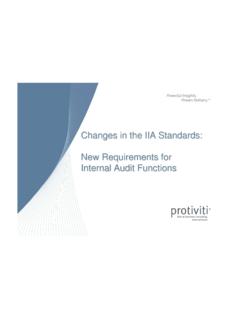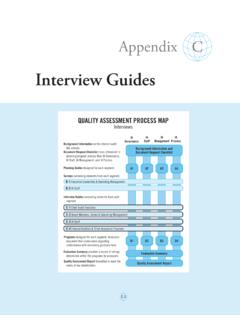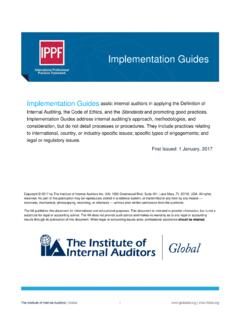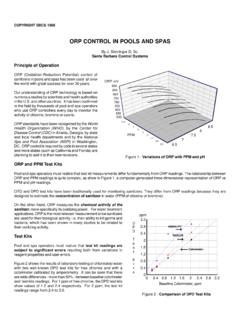Transcription of The Value of Internal Audit - IIA
1 The Value of Internal Audit (*) Today, more than ever, the question of Value has taken on critical importance in every organisation. In an increasingly global economy with increasingly tougher competition, all business activities have to look to contribute more Value . Internal Audit is no exception to this. As a support and control function that is not directly linked to the main goal of organisations, which is the supply of goods and services, Internal Audit has to demonstrate its Value , more than any other activity. While an operational or commercial activity is visible and can be more easily identified as delivering more Value (price, quality, service) to its recipient, Value is more difficult to define for Internal Audit .
2 The Value of Internal Audit is reflected in an improvement in Internal control and the risks that face organisations, an improvement that leads to a reduction in those risks to acceptable levels. In other words, from a starting point of a significant inherent risk, to arrive at a situation where the residual risk is tolerable. Thus, the Value of Internal Risk can be expressed as follows: Ri Rr VAI = ------------- RAI VAI = Value of Internal Audit ; Ri = Inherent Risk; Rr = Residual Risk RAI = Internal Audit Resources On the face of it, it seems easy to identify and so increase the Value of Internal Audit : it is simply a question of increasing Ri and reducing Rr and the resources used. Ri is increased by Internal Audit carrying out work on those areas of greater inherent risk.
3 The resources of Internal Audit are scarce for the business processes and units to be audited. In each time period, business processes and units of higher risk must be selected. Thus, a large part of the Value of Internal Audit is earned at the phase of the planning and selection of work. The Ri also increases by identifying for each work item the risks with greater impact and frequency, focusing the execution and reporting of the Audit on these risks. The Rr is reduced through recommendations and the implementation of resulting and effective action plans that lead to risks being moved towards acceptable and tolerable levels, always bearing in mind that Rr>0. For this, getting the commitment of Audit customers and monitoring action plans are necessary.
4 Finally, the Value of Internal Audit is achieved through the efficient use of the resources available: people and tools. As in all activities, the Value of Internal Audit depends to a large extent on people, or in other words, good leadership and good work teams. Both leadership and the teams depend on the general and specific preparation of the people involved. And in this respect, a solid knowledge of the business and continuous professional development, through attendance at training courses and gaining international certifications, such as IIA qualifications (CIA, CGAP, CFSA and CCSA), contributes greatly. At the same time, the means used must be appropriate to the goals aimed for.
5 In other words, cost/benefit analysis is always necessary to ensure that disproportionate means are not used in relation to the expected results, and that the result of the results/resources used equation is always positive a factor greater than 1. But it is not enough to increase real Value ; it is also necessary to increase perceived Value . And this depends on the ability of Internal Auditors to communicate and on inter personal skills. The Internal Auditor manager must be a leader capable of relating to and influencing people at the highest levels. Internal Audit reports and their communication must be effective, and have an impact on their targeted audiences: they should be written not just to be read but to convince and lead to action being taken that produce results.
6 Good planning and execution of Internal Audit work can be wasted due to less than efficient communication and reporting. However, the Value of Internal Audit contains a great paradox, which becomes a contradiction in terms: the greater the Value in the present, the less the Value in the future. In other words, the lower the level of risk in the organisation (this being the objective of Internal Audit ), the less Value will be attached to Internal Audit s Value , which depends directly on the level of risk in organisations. Does this mean therefore that we should regulate present Value in order to continue to have Value in the future? This approach is not recommended.
7 We should always search to maximise Value at every moment, since as living entities, organisations are not static, but on the contrary, dynamic, and (inherent) Risk also varies from one time period to the next. Organisational risk is in constant flux, which accompanies the business management cycle: less risk means being ready and prepared to take on greater risk and take advantage of new opportunities. And if at times we manage to reach the desirable point of contributing towards a situation where all of an organisation s risks are at acceptable levels, we will always contribute towards maintaining this risk level through follow up audits and improvement actions. On the other hand, the Value of Internal Audit does not depend exclusively on direct results but also on its indirect impacts and effects on the activities of the management and directors of companies.
8 Internal Audit contributes towards increasing comfort for and guaranteeing management processes, and has a relevant role in building and maintaining confidence within the organisation and between management and directors. It also contributes towards providing comfort and guaranteeing the control of business risks; promotes the alignment of objectives at all levels of the organisation; facilitates decentralising management, delegating and making business functions autonomous; is a mechanism that enables management to be optimised and develop qualitatively; and is a factor of innovation, since it allows more risk to be assumed and opportunities to be seized. In summary, the Value of Internal Audit depends on: - Planning based on the organisation s main risks; - Execution and reporting focused on the most frequent risks and those with the highest impact; - Consequential and effective recommendations and action plans that lead to risks at acceptable and tolerable levels; - Good leadership and good teams with solid knowledge of the business, continuous training and international certifications; - An efficient utilisation of available resources; - The ability to influence, and to have efficient communication and inter personal skills.
9 And we should not be concerned that we may lack Value in the Domingos M. Sequeira de Almeida, CIA, CCSA IIA member ID: 1041719 President of the IPAI - Instituto Portugu s de Auditoria Interna (IIA Portugal) (*) First published in Auditoria Interna (IIA Portugal magazine). Translated by Philip Lindsay Burns.















